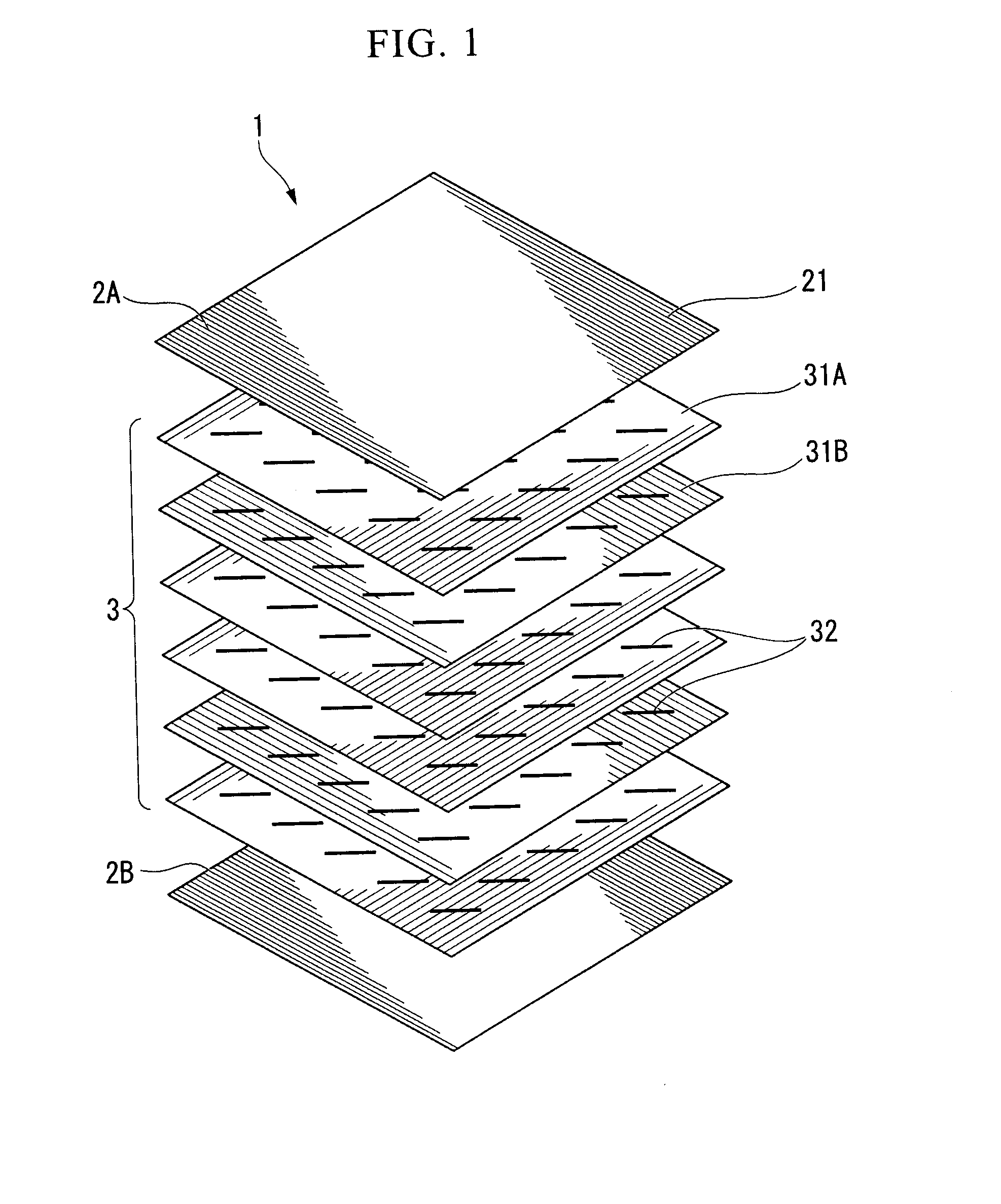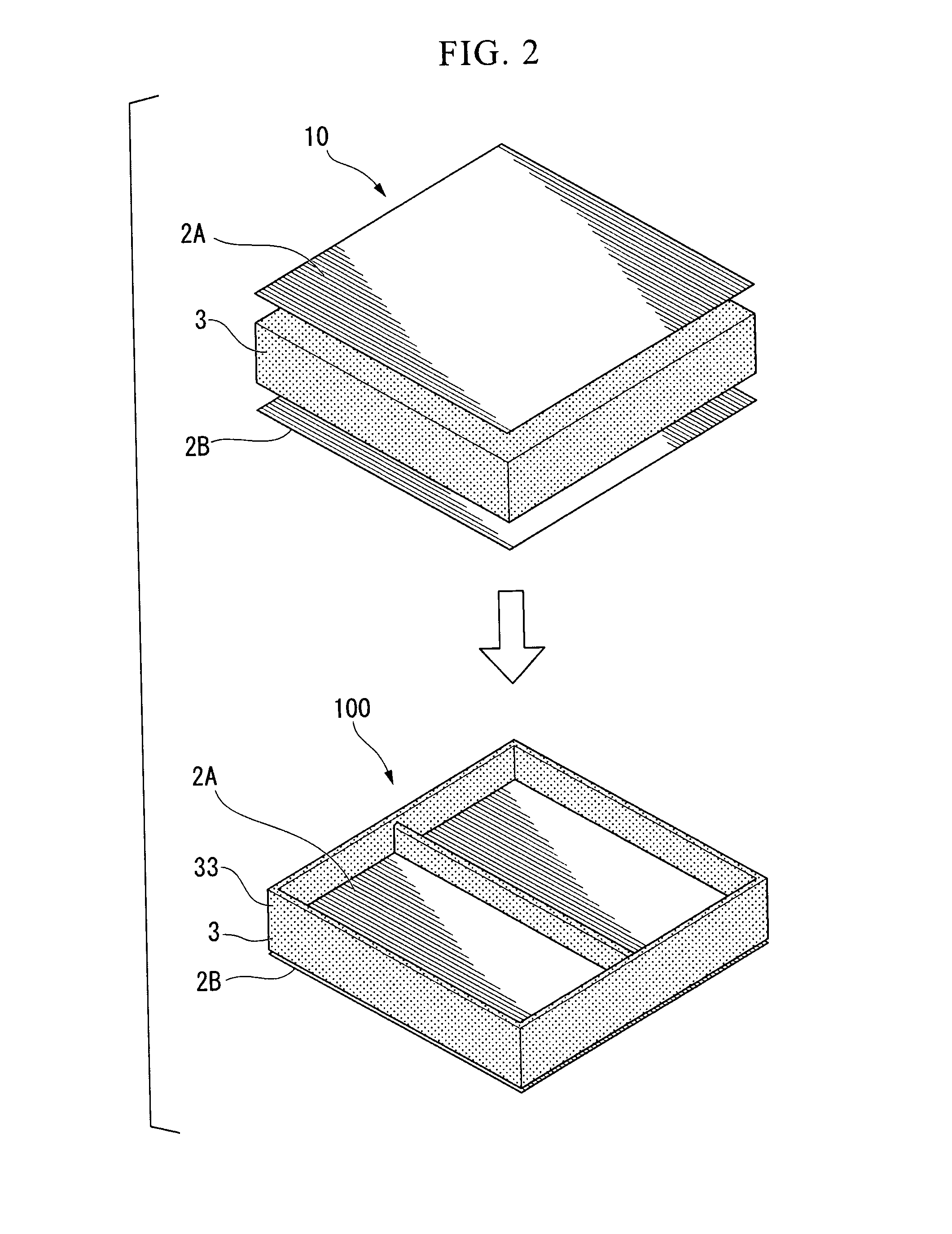Carbon-fiber-reinforced thermoplastic-resin composite material and molded body using the same
a technology of thermoplastic resin and composite material, which is applied in the direction of synthetic resin layered products, other domestic articles, ceramic layered products, etc., can solve the problems of relative long molding time, and achieve the effect of short molding time, excellent balance of stiffness, strength and thermal conductivity
- Summary
- Abstract
- Description
- Claims
- Application Information
AI Technical Summary
Benefits of technology
Problems solved by technology
Method used
Image
Examples
production example 2
Method of Manufacturing Prepreg Containing polyacrylonitrile-Based carbon Fiber at 33% by Volume
[0127]A polyacrylonitrile-based carbon fiber (product name: PYROFIL (registered trademark) TR50S15L manufactured by Mitsubishi Rayon Co., Ltd., basis weight: 1000 mg / m, tensile modulus: 240 GPa, tensile strength: 4900 MPa, breaking elongation: 2.0%, and density: 1.82 g / cm3) as the carbon fiber (B) was pulled and aligned in one direction so as to have FAW of the carbon fiber contained per unit area of 72 g / m2, sandwiched between two acid-modified polypropylene films having a thickness of 40 μm to overlap each other, and heated and pressurized at 250° C., thereby manufacturing a sheet-like prepreg (II) containing a carbon fiber at 33% by volume. The thickness of this sheet-like prepreg (II) was 0.12 mm.
example 1
Composite Material Including Pitch-Based carbon Fiber Prepreg in Outer Layer
[0128]The prepreg (I) which was obtained in Production Example 1 and contained a pitch-based carbon fiber was disposed at the first layer and the 16th layer and the prepreg (II) which was obtained in Production Example 2 and contained a polyacrylonitrile-based carbon fiber was disposed at from the second layer to the 15th layer to overlap each other such that the direction in which the fiber was pulled and aligned was matched with each other and the prepregs were 16 layers in total, and these prepregs were disposed in the mold. This mold was heated for 3 minutes in a press molding machine set to 220° C., further pressed for 7 minutes at 220° C. and a pressure of 2 MPa, and subsequently pressed for 3 minutes at 30° C. and a pressure of 2 MPa, thereby obtaining a composite material having a thickness of 1.9 mm. The measurement results of the bending test and the thermal conductivity are presented in Table 1.
example 2
Composite Material Including Pitch-Based carbon Fiber Prepreg in Inner Layer
[0129]A composite material having a thickness of 1.9 mm was obtained in the same manner as in Example 1 except that the prepreg (I) which was obtained in Production Example 1 and contained a pitch-based carbon fiber was disposed at the second layer and the 15th layer and the prepreg (II) which was obtained in Production Example 2 and contained a polyacrylonitrile-based carbon fiber was disposed at the first layer, from the third layer to the 14th layer, and the 16th layer.
[0130]The measurement results of the bending test and the thermal conductivity are presented in Table 1.
PUM
| Property | Measurement | Unit |
|---|---|---|
| elastic modulus | aaaaa | aaaaa |
| elastic modulus | aaaaa | aaaaa |
| length | aaaaa | aaaaa |
Abstract
Description
Claims
Application Information
 Login to View More
Login to View More - R&D
- Intellectual Property
- Life Sciences
- Materials
- Tech Scout
- Unparalleled Data Quality
- Higher Quality Content
- 60% Fewer Hallucinations
Browse by: Latest US Patents, China's latest patents, Technical Efficacy Thesaurus, Application Domain, Technology Topic, Popular Technical Reports.
© 2025 PatSnap. All rights reserved.Legal|Privacy policy|Modern Slavery Act Transparency Statement|Sitemap|About US| Contact US: help@patsnap.com



